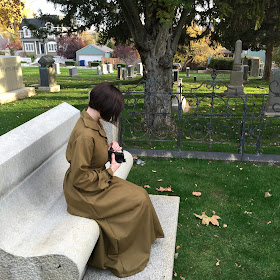When I was in my first year of university, I took a Celtic Civilisation course. My professor is a native of Scotland, and she told us that her children would carve turnips, which was the traditional Scottish vegetable of choice. Instead of trick-or-treating, Scottish children used to go guising, wearing fearful home-made masks. The book 'The Silver Bough' by F. Marian McNeill gives a detailed account of these traditional Halloween traditions and practices.
This year, I really wanted to recreate a Scottish Halloween as much as possible. The weekend before Halloween I carved pumpkins with my mum, sister and niece. But my mother and I also carved turnips. Turnips (or rutabagas) are much smaller than pumpkins, and frankly, more difficult. The whole inside needs to be carved out. But the result is definitely worth it.
Carving the turnip!
Below: my mother's turnip on the left, and mine on the right.
On Halloween itself, I made Scottish oat cakes. I used a recipe from my grandmother Jean Grant McCloud (her parents were both Scottish), which she got from a hotel in Nova Scotia. Instead of baking them, however, I fried them on a 'girdle' (a griddle-iron), which is more traditional.
 |
| The recipe if you want to try it. One of my sisters recently made some and put some chocolate on top, which makes them quite similar to Hobnobs. YUM! |
I've made these oat cakes before, but have never fried them. The consistency is different, but however you cook them, they are pretty delicious! I also reduced the sugar and butter this time because it seemed like SO MUCH!




















